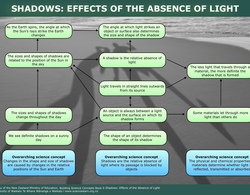
Many materials fall into one of two broad groups, transparent or opaque, depending on whether light can pass directly through the material or not.
Transparent materials let most light pass through them without noticeably scattering or absorbing it. Transparent materials are common in nature, for example, pure water, air and the crystals of many minerals. Opaque materials let no light pass through them. Many of the materials we use every day come into this category. Shadows form where light cannot pass through an opaque object.
Some materials are translucent. They allow some light through but scatter the rays so much that any object viewed through the material cannot be seen clearly. (Think of seeing something through frosted glass.) Plastics, oils, waxes and fats are usually translucent. The shadows formed by translucent materials are lighter and less definite than those formed by opaque materials.
Related article
Related images
Related activity
IMAGE: The University of Waikato Te Whare Wānanga o Waikato


